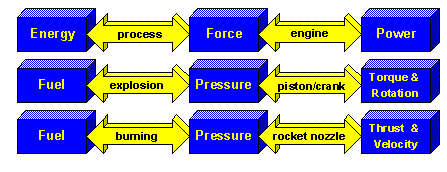Energy, Power and Force
An Engine
The Propeller
How a Propeller Works
Aerodynamic Characteristics of Propellers
Measuring the Geometry of Propellers
Equivalent Multiblade Propellers
Static Thrust of Propellers
Effect of the Propeller on the Aircraft
Moving a vehicle, may it be on the ground, on the water, or in the air, requires a force to overcome the friction and inertia forces and to lift the vehicle to a different elevation. A force can be created from any kind of energy, like the energy contained in liquid fuel for an internal combustion engine, the electric energy stored in a battery or like solar energy being transformed by solar cells into electric power. To actually move an object, the force must be must be translated by some sort of engine into power, pushing the vehicle forward. Burning fuel in an open pan does not create a force and having a bottle of compressed air lying around creates a force on the bottles walls, but does not create any power output. Energy may be static (fuel) or dynamic (flywheel), force is static and power is always dynamic. Power equals force times distance per time.

Process of converting stored energy into power which can be used to move a
craft.
An EngineThe lack of powerful, lightweight engines was one of the reasons for the failures of early attempts to fly. Using natural sources of energy like thermals requires quite sophisticated sailplanes, which were of course not available in the beginning. When steam engines became available, they proved to be too heavy for flight, compressed air engines or twisted rubber bands could be used for smaller demonstrations, but were not practical or to heavy for man carrying airplanes. Finally the piston engine, burning fuel of high energy content internally, was to become the first successful power plant for aviation. From the early days of the Wright brothers until the 1950s this type of engine was the main source of aerial propulsion. |
|
|
|
The PropellerHaving a power plant available is only one part of aircraft propulsion, we also need means to transform the power output of the engine into something useful. Piston engines usually drive a rotating shaft, which must be connected to a device which, "in turn", creates a thrust force, finally advancing our vehicle. The idea of placing an "inclined plane" on a rotating shaft
is astonishingly old. It was probably first used to pump water (the
"Archimedes screw") and later
in windmills. |
Propeller or Airscrew?Propellers have also been called airscrew in the past, but this term may be misleading, because a propeller does not move like a mechanical screw through a rigid medium. You don't call a wing knife or slicer because it also does not slice through the air in the direction of its inclined mean plane. Each section of a propeller (or of a wing) has a certain angle of incidence and is moving through the air at its unique angle of attack - both are independent. On the other hand, a mechanical screw or a knife moves through a rigid material exactly in the direction which is given by its pitch or angle of incidence - a screw with different pitches along its radius would get stuck, a propeller would not. |
|
Where do you want to go now?
![]() Design a Prop
Design a Prop ![]() Optimum Propellers
Optimum Propellers ![]() How a Propeller works
How a Propeller works
![]() Equivalent Multiblade Propellers
Equivalent Multiblade Propellers
Last update of this page: November 9th 1996
Last modification of this page: 21.05.18
![]()
[Back to Home Page] Suggestions? Corrections? Remarks? e-mail: Martin Hepperle.
Due to the increasing amount of SPAM mail, I have to change this e-Mail address regularly. You will always find the latest version in the footer of all my pages.
It might take some time until you receive an answer
and in some cases you may even receive no answer at all. I apologize for this, but
my spare time is limited. If you have not lost patience, you might want to send
me a copy of your e-mail after a month or so.
This is a privately owned, non-profit page of purely educational purpose.
Any statements may be incorrect and unsuitable for practical usage. I cannot take
any responsibility for actions you perform based on data, assumptions, calculations
etc. taken from this web page.
© 1996-2018 Martin Hepperle
You may use the data given in this document for your personal use. If you use this
document for a publication, you have to cite the source. A publication of a recompilation
of the given material is not allowed, if the resulting product is sold for more
than the production costs.
This document may accidentally refer to trade names and trademarks, which are owned by national or international companies, but which are unknown by me. Their rights are fully recognized and these companies are kindly asked to inform me if they do not wish their names to be used at all or to be used in a different way.
This document is part of a frame set and can be found by navigating from the entry point at the Web site http://www.MH-AeroTools.de/.